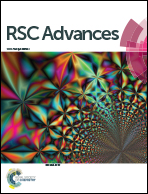Sensitive CE-ECL method with AuNPs-enhanced signal for the detection of β-blockers and the study of drug–protein interactions
Abstract
A sensitive capillary electrophoresis (CE) system coupled with electrochemiluminescence (ECL) of tris(2,2′-bipyridyl) ruthenium(II) is described for the detection of propranolol (Pro) and acebutolol (Ace). AuNPs were added to the end column luminescent reagents solution to enhance the sensitivity of the CE-ECL system. Experimental conditions of separation and detection as well as the amount of AuNPs were optimized. Under the optimum conditions, the linear range of Pro is 0.01 to 100 μmol L−1 with the LOD of 3.6 × 10−9 mol L−1 (S/N = 3) and with the LOQ of 1.1 × 10−7 mol L−1 in human urine samples (S/N = 10). For Ace, the linear range is 0.02 to 100 μmol L−1 with the LOD of 5.0 × 10−9 mol L−1 (S/N = 3) and with the LOQ of 9.5 × 10−8 mol L−1 in human urine samples (S/N = 10). RSDs (n = 3) of the migration time for Pro and Ace are from 1.9 to 2.4% intraday and from 2.9 to 3.8% interday. RSDs of the peak area for Pro and Ace are from 3.2 to 3.7% intraday and from 4.3 to 4.6% interday, respectively. The developed method was successfully used to determine two analytes in human urine samples. In addition, the interaction between Pro as a model analyte and human serum albumin (HSA) was investigated; the number of binding site and the binding constant of Pro with HSA are 1.0 and 2.3 × 104 L mol−1, respectively.


 Please wait while we load your content...
Please wait while we load your content...